By: Hassan Al-Haifi
TunisIan youth and labor joined together to bring about the fall of Zein Al-Abideen Bin Ali as President of Tunisia on 14 January 2011 and President Husni Mubarak of Egypt on 11 February 2011.
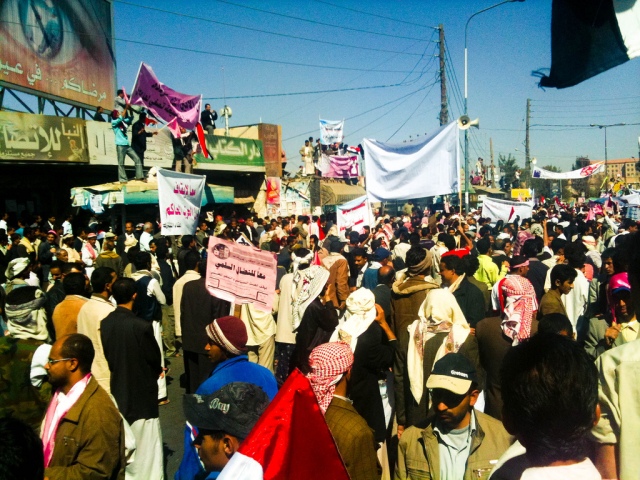
Yemeni Youth take to street in Yemen Spring Revolt in February 11, 2011 and again in September 2014.
Yemeni youth were not to be outdone by their piers in Tunisia and Egypt, especially as President Ali Abdullah Saleh had ruled Yas dictator of Yemen for 33 years (See https://yemenonthethreshold.wordpress.com/2018/03/27/the-senseless-war-on-yemen/, for background on Saleh’s rise to power). I recall predicting the downfall of Saleh in an interview on Al-Jazeera on February 13, 2011, when Yemen’s Arab Spring was just getting started. (https://m.youtube.com/watch?v=IN92YgQrqHQ). Unlike the revolts in Tunisia and Egypt, Yemen’s protests were more violent and bloody. By March 2012, when the revolt ended and Yemen entered a transition period envisioned by the Gulf Cooperation Council (GCC) Initiative, 2000 mostly youth protesters were martyred as forces loyal to Saleh stubbornly sought to quell revolt. Initially, the youth from various members of the Joint Meeting Opposition Parties (Islah, YSP, Nasserites, Hizb Al-Haq, Popular Forces, etc), Ansar Allah, the Southern Movements and thousands of independents joined in the protests. By March 18, 2011, the protests were getting more frequent and the regime more repressive. On that fateful day 52 protesters were shot dead and hundreds wounded, with the regime set to remove the protesters camping on Ring Road West adjacent to Sana’a University by force. But the protesters stubbornly held on.
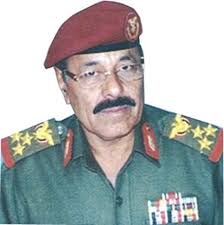
General Ali Muhsin Al-Ahmar, a Saleh half brother, former right-hand man and Saudi long-time favorite stooge and supporter of Wahhabi propogation in Yemen. He helped facilitate terrorist activities in Yemen. Defected to Youth protesters and made himself “protector of protesters”. Now Hadi’s Vice President in Exiled Hadi Government
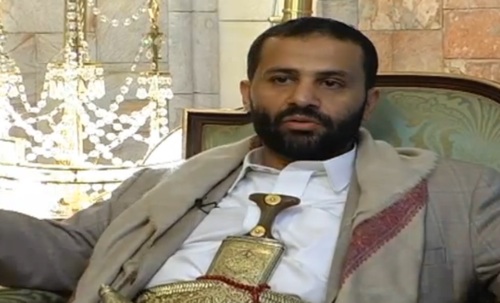
Hamid Abdullah Al- Ahmar: Son of former Paramount Chief of Hashid Tribe, businessman and Islahi Leader, also defected to youth protesters.
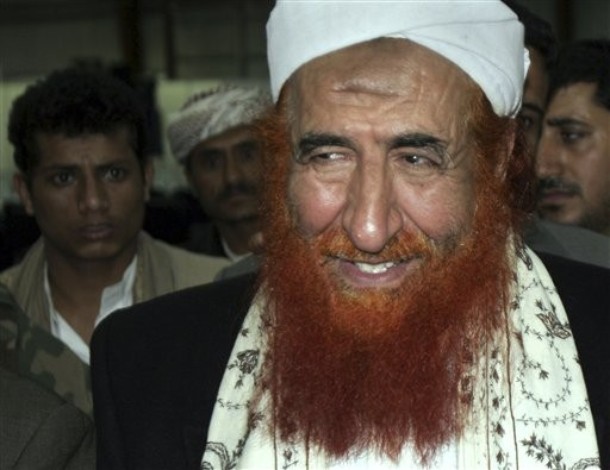
Abdul-Majid Al-Zindani, Spiritual Mentor of Wahhabis in Yemen and Spiritual leader of Islah Party. He and a number of Wahhabi clerics joined Youth Revolution. Zibdani enjoys very close relationship with Saudi Wahhabi clerical establishment and is beneficiary to substantial Saudi funding from the Early Seventies.
The Islah Party is aligned with the Muslim Brotherhood, although more ideologically extreme.
By May 2011, several of Saleh’s former tribal allies and military commanders presumably joined the protesters and the protests turned into street confrontations between Saleh’s remaining forces and those who have joined the protests. The peaceful nature of the protests had deliberately turned violent and confrontational. The Revolution had been intentionally hijacked from the peaceful youth protesters. The protesting youth had become sidelined.
The so-called defections of course were seen by many of the protesters as a dangerous attempt to circumvent the peaceful protests or to kidnap the Revolution by elements of those who were seen as representing the other side of the Saleh Regime
As events in Yemen turned more bloody and violent, the most archaic absolute monarchies in the region, which comprised the Gulf Cooperation Council, in order to “steer” Yemen to democratic civil Government, came up with a called the GCC Initiative signed by the same old political factions that were in the political arena for a third of a century hence, with little effective political weight, with Ali Abdullah Saleh reluctantly signing in November 2014. The Initiative was to insure that Yemen was to remain under Saudi hegemony. Saleh had just survived and completed treatment for burns from a mysterious explosion that covered 40% of his body in the Presidential Palace in Early June 2011 (https://www.telegraph.co.uk/news/worldnews/middleeast/yemen/8554795/Yemens-President-Saleh-wounded-in-palace-attack.html).
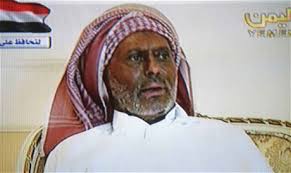
Late President Ali Abdullah Saleh showing some of the burns of explosion in Presidential Palace in June 2011 before completion of treatment in Riyadh.
The Saudis came to pick him up with a specially equipped Medical Air Ambulance on the day of the attack. He was treated in Riyadh.
The GCC Initiative: Saleh was to step down (with all immunity granted from all accountability for his crimes and corruption) and his Vice President takes over for a transition period of two years. A National Dialogue Conference (NDC) would take place to arrive to a permanent political settlement, and national elections are held. Hadi’s mandate was extended by NDC, without due process and authority, after two year tenor expired.
“Although Yemen’s February 11 revolution aimed to oust the old, corrupt regime and establish a new one, the traditional political and societal elites succeeded in diverting the course of the revolution to a process of negotiations which culminated with the signing of the Arab GCC’s initiative, on November 23, 2011” (https://www.dohainstitute.org/en/PoliticalStudies/Pages/Outcomes_of_Yemens_National_Dialogue_Conference_A_Step_toward_Conflict_Resolution_and_State_Building.aspx).
. The National Dialogue was concluded, after several if its key participants were assassinated (mainly Ansar Allah members).
Vice President Abdu Rabbo Mansour Hadi proved unable to provide the leadership that would get all the political factions to work together during the transition and thereafter.
Ansar Allah and the Southern Movement did not approve of the GCC Initiative, but did take part in the National Dialogue. Three Ansar Allah delegates to NDC were assassinated as the National Dialogue Cinference was nearing completion along with other leading politicians. Corruption continued to plague the Hadi government, as well as terrorist acts that hit several military, security and civilian government institutions.
In the meantime, Saudi Arabia propped up its “stooges” in the Hashid Tribe and the Salafi settlements in Sa’ada Governorate to intimidate Ansar Allah in their Sa’ada stronghold. Ansar Allah easily overcame these efforts to bring AA to an end. AA took over the Salafi settlements in Kitaf and Dammaj and drove the foreigners out of these foreign settlement enclaves in their stronghold. Most of the Wahhabi Salafi settlers in these enclaves were imported from Wahhabi terrorist fertile grouns from Asia, Africa, Europe and other Arab countries. These settlements were also important lab centers for producing explosives for suicide bombing missions and bomb cars. Hussein Abdullah Al-Ahmar and military units allited with General Ali Muhsin Al-Ahmar, a long time supporter of Wahhabi and terrorist groups in Yemen continued to fight against the Houthis, with the Houthis proving not only unbeatable, but able to push southward taking the former Al-Ahmar stronghold of Khamir to Amran where they defeated the last Ali Muhsin Brigade with the killing of Brigadier Hameed Al-Gushaiby in Amran. (Al-Qushaibi’s son was caught in Sana’a Airport with US $17 million just days before. This proves the wars in Sa’ada were just contracted wars.
In the meanwhile in Sana’a protests were being organized against rising fuel prices, corruption and the poor security situation with increasing assassinations and terrorist bombings. (https://www.google.com/amp/s/mobile.reuters.com/article/amp/idUSKBN0GI1O420140818). The peaceful protesters in Sana’a allied with the General People’s Congress and the Ansar Allah to demand more responsive government to people’s demands especially against corruption. Since the Government of Hadi did not respond, the protests demanded action or they would bring the Government down. In the meantime, the forces still loyal to Ali Abdullah Saleh joined the protests and the Revolution of September 21, 2014 removed the traditional power elites such as General Ali Muhsin, the Al-Ahmar tribal chiefs, etc. from control of Government institutions.For additional information on Houthis advance to Sana’a, see https://www.counterpunch.org/2014/10/31/the-houthi-advance-on-yemens-capital/
At this stage the Special UN Envoy, Jamal Bin Omer (appointed in August 2012) to steer Yemen to a peaceful political transition) brought together all the active political factions. He was able to negotiate a Peace and Partnership Agreement (PPA), which all factions signed (September 22, 2014, including President Hadi. Bin Omer took the PPA to the GCC, the Group of Ten (supervising implementation of GCC Initiative) and the Security Council, all of which approved the PPA by Mid October. He then set out to finalize the steps to final political framework and all parties agreed to most of the needed steps.
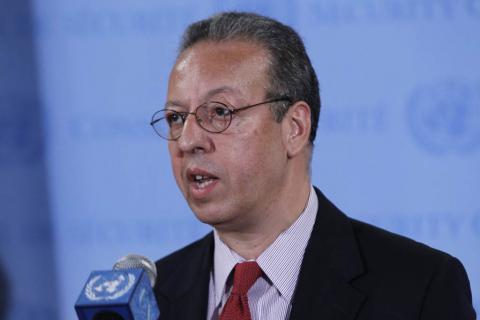
Jamal Bin Omer, Assistant Secretzry General and Special Envi oy to Yeme from August 2012 to April 15, 2015, when Saudis insisted he resign because he refused to be on their take. He knew well that Yemen’s problem stem from fifty years of Saudi meddling in Yemeni affairs. He knew and the Saudis knew that the Peace and Partnership Agreement meant no more Saudi influence. That is why to this day they refuse to even have it mentioned in UNSC.
However, Abdu Rabbo Hadi after resigning and withdrawing his resignation more than once escaped to Aden. Jamal Bin Omer carried on to finalize agreement with all sides and by March had a blueprint for a political settlement in all the Government institutions except for the Presidency, which would require little time to work out (http://mobile.abc.net.au/news/2015-04-16/un-peace-envoy-to-yemen-jamal-benomar-resigns/6397312). Of course, the Saudis, with their senseless aggression have rendered it impossible for JBO to complete his nearly complete blueprint for a political settlement. The Saudis did never like the highly qualified, clean and incorruptible diplomat, who could be said had a good grasp of the fact all of Yemen’s problems are a product of long time Saudi meddling in Yemeni affairs. They used all pressure to force him to resign, which in effect killed all chances of a peaceful settlement to the war and the political crisis (https://www.wsj.com/articles/former-u-n-envoy-says-yemen-political-deal-was-close-before-saudi-airstrikes-began-1430081791).
Back on the ground again, Government forces in Ta’ez and Aden were facing attacks from Islahi militias, Al- Qaeda and ISIS elements recently brought from Syria and Iraq by Turkish aircraft. When reinforcements were sent to rescue them, fghting got fierce and government forces held their ground, as much as possible. By March 25, fighting was heavy in Aden and President Hadi escaped to Oman and then Saudi Arabia.
In the meantime, Saudi Arabia, with the US put together a Coalition to do what it could not do in Six Wars in Sa’ada and later contracted wars to tribal mercenaries: bring an end to the Ansar Allah and all its allies in Yemen, and now including former President Ali Abdullah Saleh and loyal governmebt forces to him, now regarded as a “rebel” along with the Ansar Allah.
All the former allies of Hadi, including the Islah, the Hashid tribal chiefs all joined together to “retake” the government they lost by their own deferense.
